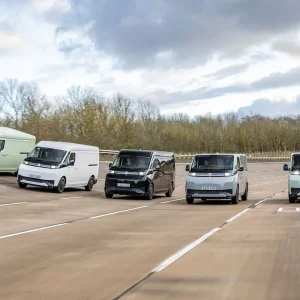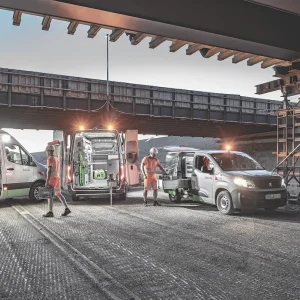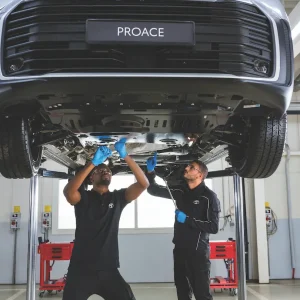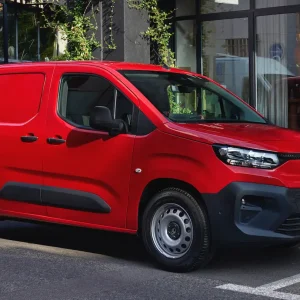While many involved in end of contract vehicle disposal will do everything they can to get the best return at auction – be it scrupulous defleeting with body repairs carried out, clearly displaying all provenance or marketing the vans through the best channels at the locations that are likely to perform – it can be equally prudent to take some time at the point of purchase to ensure that the vehicle will be attractive to a second owner.
Steve Botfield, senior editor for commercial vehicles at cap-hpi, thinks there is a real benefit from including some relatively straightforward options for the van at the point of ordering. “Air conditioning was a luxury item a number of years ago, but manufacturers have now woken up to the benefit of having it as standard on some models, so for buyers that is something they are looking for if the model does not come with it,” he explains.
“With the cost of repairing external damage, front and rear parking sensors with or without a camera are an item that has become desirable. As most likely the first users have benefitted from not having any external damage, it is always good to buy or sell a vehicle that has bodywork that is as it was when it left the factory. Also, cruise control with speed limiter is a must, to reduce those dreaded speeding penalties and aid fuel economy in the long run.”
Although the option would have to be practical for the first life of the van, Botfield highlights the fact that a vehicle with an unusual configuration, that is therefore short in supply, can reap benefits at selling time. “One example is a medium-sized van that normally would be equipped with twin rear doors, but some operators require a tailgate, which in the used market becomes much more desirable for conversion into a leisure-type vehicle.”
Andy Picton, chief commercial vehicle editor at data provider Glass, agrees with this view and also notes that a high-spec van on a manufacturer’s price list (rather than a base model with options) will usually generate a more accurate trade value in the auction catalogue, which will influence buyers. “This allows for a specific residual value (RV) to be set, with the higher specification models receiving the strongest RV in the used market,” he says.
“Historically, vans with car-like features such as air conditioning, alloy wheels, satnav, rear parking sensors and metallic paint have always performed well, especially on medium-sized vans like the VW Transporter, Ford Transit Custom, Renault Trafic and Vauxhall Vivaro. Crew van versions of these vans have also opened up the interest to a wider audience. For larger vans, the in-demand features tend to be the same, with slightly less emphasis on alloy wheels. Mileage and condition are vitally important as this size of van tends to be harder worked, with damage more costly to repair.”
Echoing this, Tim Spencer, commercial vehicle manager at Shoreham Vehicle Auction, says that today’s buyers want the same specification from a van that they would expect from a car.
“The retail forecourts are evidence of that. Age, mileage, convenience features and vehicle finish are the key criteria. The expectation is that certain levels of equipment and trim are a given at different price points, and the higher the specification the greater the demand,” he explains.
“Convenience features such as air conditioning and reversing sensors are now very much a standard requirement when it comes to van specification. More than 90% of buyers are looking for these features as standard to provide end users with the specifications they expect to see.”
It’s not just specification, though, highlights Geoff Flood, Aston Barclay’s national LCV manager. The days of vans mostly being available in any colour as long as it is white are long behind us.
“Colour is one big differentiator at auction. In our most recent auction, a 68-plate, 88,000-mile gold Transit Custom made £13,300, while a white 18-plate Ford Transit Custom with 91,000 miles on the clock made £9,100. The gold Transit made nearly £2,000 more than book and the white van £500 more,” he says.
Flood understands the buyer’s rationale for being prepared to pay extra for a van with a good specification. “Many of the SMEs buying a used van want their business and their vehicle to stand out in the crowd when they are driving locally or when it is parked outside someone’s house. Therefore, they are prepared to invest in buying a higher spec van at auction. Also, younger tradespeople can only afford to buy and insure one vehicle, so often they are buying a high-spec van in a good colour and using it in the week for work and at the weekends and evenings for leisure.”
Although current market conditions mean that a lower specification won’t necessarily result in poor results at auction, it would be prudent to think ahead. A Transit Custom Limited will have a higher initial outlay compared with the entry-level Leader model, but the van in a nice metallic colour will command a substantial premium at disposal time. Not only this, but you’ll have a happier driver and a van that projects a strong, positive image for your business.
What’s in a (brand) name?
We asked our panel just how brand sensitive the market is – would a lower spec Volkswagen Transporter be in higher demand than a top of the range Vauxhall Vivaro, for example? Their answers were almost unanimous in the current overheated used van market:
Cap-hpi’s Botfield says: “In 2020 anything that could carry volume was being snapped up without any regard to the badge or specification. When we do get back to normal times, it is what is in the market in numbers that will determine if one manufacturer is preferred over another, and this is ultimately linked to the marketing machines of the manufacturers.”
SVA’s Spencer adds: “Currently, within such a buoyant market, people are simply buying whatever they can get their hands on. Brand and model is almost secondary to availability and specification right now. Like any market, specific brands do generally create greater demand, but specification has a crucial role to play in that.”
Aston Barclay’s Flood agrees: “Such is the shortage of stock in the used market that currently if the van is in good clean condition it does not matter what badge is on the bonnet – it will still attract strong bids and a good price. Mercedes-Benz and Volkswagen have for a long time been the brands to look up to, but the Ford product in 2020 and 2021 is getting much closer to the German brands when it comes to strong residuals.”
Stuart Pearson, BCA chief operating officer says: ‘“Any vehicle in a good retail colour and specification generates a huge amount of interest with buyers, with metallic colours typically creating a flurry of bidding when they are offered for sale.”
Glass’s Picton notes: “It depends on many factors like condition and mileage, but generally yes, a lower spec ‘top brand’ model would expect to achieve a stronger RV than a top of the range model from another. By and large, there are no poor brands.”





